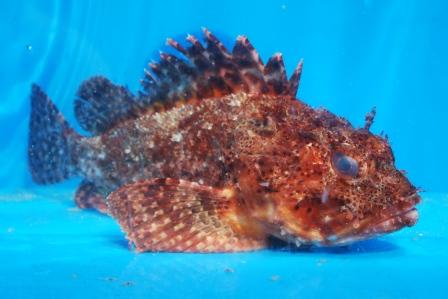
A grumpy looking scorpionfish
Don’t touch the spines on a scorpionfish or Scorpaena guttata. (And here I thought that nothing rhymes with with the famous Lion King phrase- Hakuna matata.) It’s called a scorpionfish for a reason. The sharp spines within its fins are poisonous and the toxin is effective even after the fish is dead. Talk about an effective defense mechanism.
Despite their toxic ways, scorpionfish are really cool looking with beautiful red, pink, cream and black stripe patterns on their fins and a more mottled pattern of the same colors on their body. But as the staff at the Cabrillo Aquarium explained, red is a warning color to predators, the scorpionfish uses fashion to say beware!
And check out this alien mode of reproduction: ”Females produce eggs imbedded in the gelatinous walls of hollow pear-shaped structures which are transparent or greenish and float near the surface. Within these structures, the eggs hatch in about 5 days.” That quote is taken straight from the fish bible Probably More Than You Want to Know About the Fishes of the Pacific Coast by Dr. Milton Love.
Scorpionfish reach up to 17 inches in length, eat small crabs and are found in tidepools and at depths of up to 600 feet along California’s coast. According to Love, scorpionfish make their biggest moves when it’s time to spawn in spring and summer. One fish Love tagged near Huntington Beach was captured 25 miles away, while another study monitored a scorpion fish that traveled 220 miles. They form big aggregations on the ocean floor during the day and then rise to the surface at night to spawn. Interesting lifestyle.
But of course there is one predator not intimidated by the spines of a scorpionfish…humans. Yes, fishermen catch scorpionfish. So you can eat one if you wish, just avoid those spines.
Leave a Reply